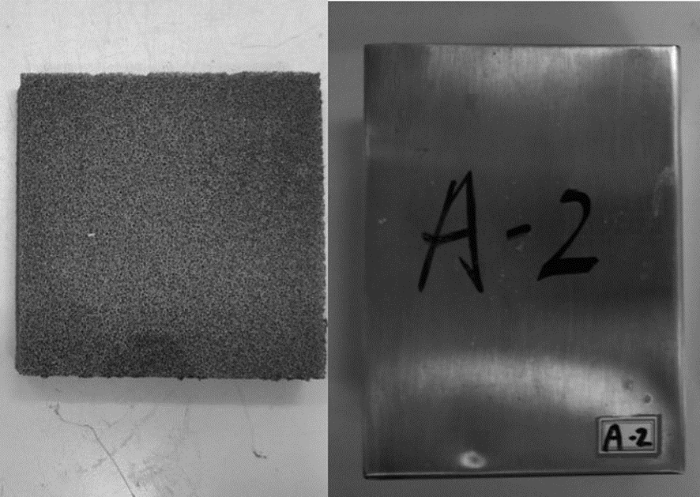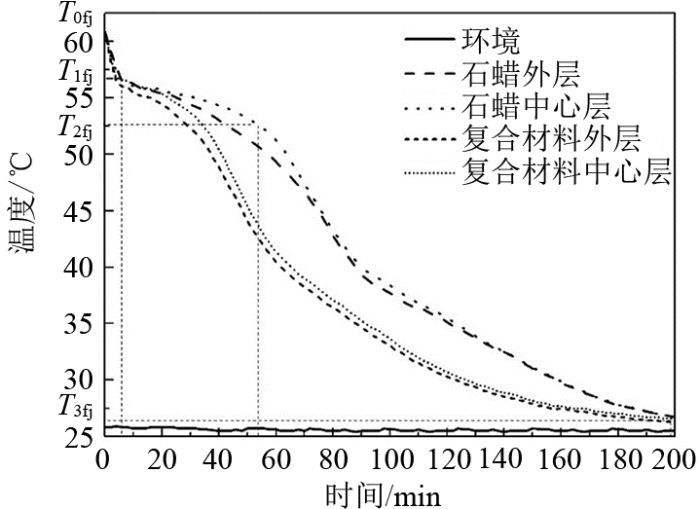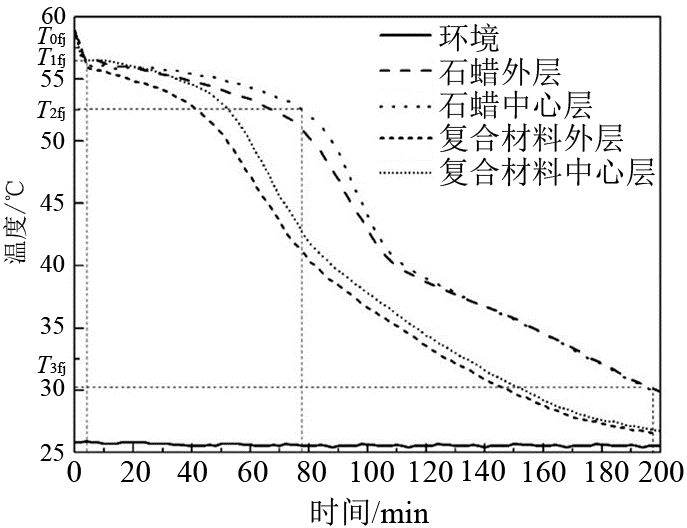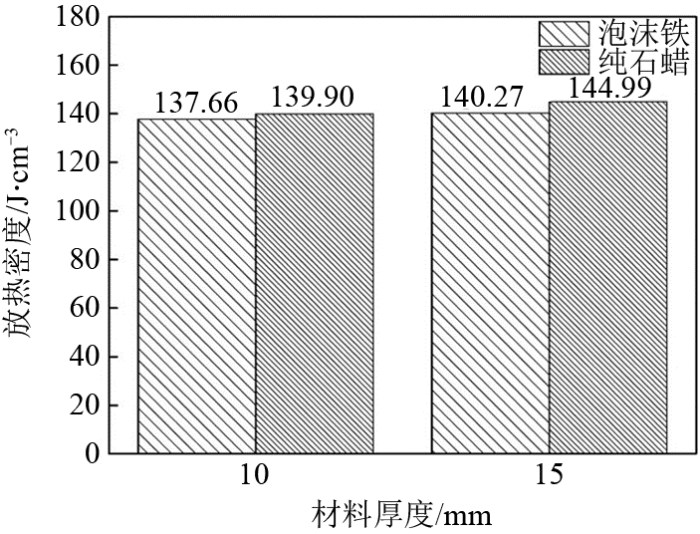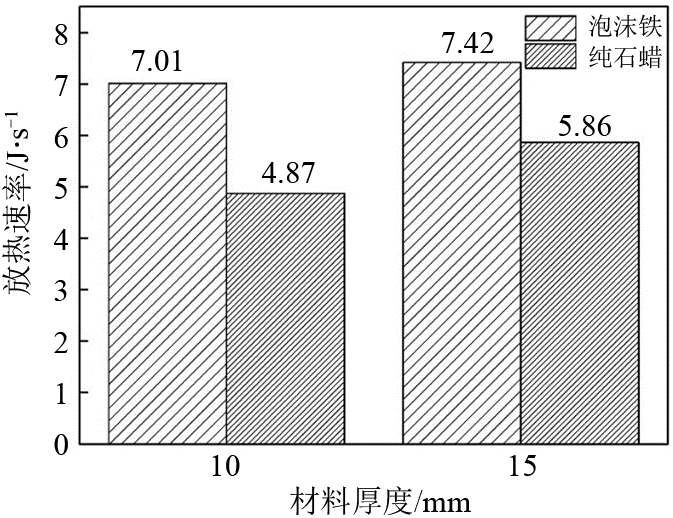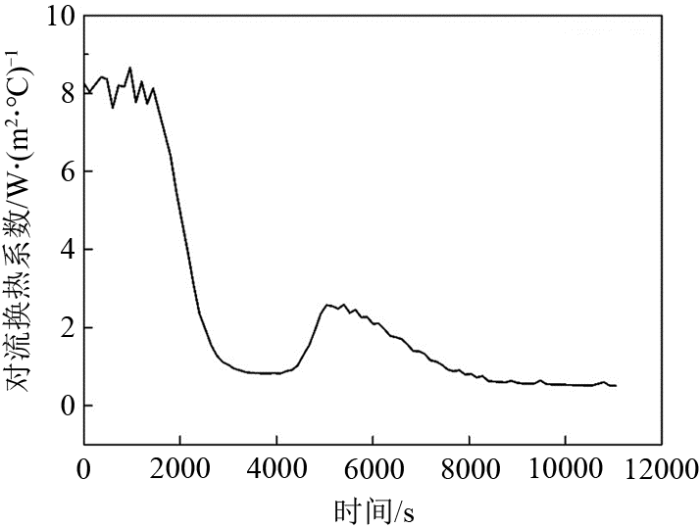近年来,随着能源供需矛盾的持续扩张[1]及生态环境的日益恶化,对可再生新能源的研发日益迫切。合理发展新能源能够优化我国的能源消费结构,减少化石能源消费[2],响应党的十九大报告所提出的加快生态文明体制改革,建设美丽中国的战略部署[3]。太阳能清洁环保,是一种应用潜力极大的可再生新能源[4,5,6],但其供应受到气候地理等因素的严重制约[7,8],开发储能技术可以一定程度上克服这些缺陷[9,10,11]。相变储能相比其他储能方式具有储能密度高,相变温度恒定,体积变化小,环境友好及成本较低等诸多优势[12,13,14]。石蜡是中低温相变范围内常用的一种有机相变储能材料(PCM)[15],具有相变潜热量大、相变温度范围广、价格低等优点[16],但石蜡较低的热导率限制了其相变过程中的传热效率[17]。泡沫金属具有质轻,比表面积大及热导率较高等优势[18,19],制备泡沫金属/石蜡复合相变储能材料可弥补石蜡热导率较低的缺陷,实现石蜡的高效储放热。
目前国内外有许多关于泡沫金属增强石蜡储能效果的研究。徐众等[20]对优选温度和时间下制备的复合相变材料的温度场分布情况和导热系数进行测试。结果表明,蓄-放热过程中泡沫铜/石蜡复合材料稳定性最好,温度分布最均匀。魏高升等[21]重点分析了泡沫金属基复合相变材料有效导热系数与泡沫金属孔隙率以及孔径的关系。结果表明,泡沫金属可以显著提高相变材料的导热系数。Wang等[22]通过实验验证了复合相变储能材料比纯石蜡具有更好的温度均匀性,且泡沫铝的添加可以提高相变储能材料的储热率。但现有研究大多数集中于泡沫金属的孔隙率、孔径及储热材料的有效导热系数,缺乏对实际系统的应用过程及对流换热能力的研究。因此,本文以石蜡作为研究对象,以其放热过程中温度变化为基础,探究了泡沫金属厚度对强化传热的影响效果,并且根据实际对流换热系数与放热时间及材料温度的关系建立了相应的关系式,为石蜡在实际放热过程中的应用提供理论依据。
1 实验材料和方法
1.1 材料与设备
图1
材料制备所用设备:智能型电热板(北京昶信科技发展有限公司)。实验所用设备:主要有干燥箱(北京汇安铭科科技发展有限公司)和温度采集系统,其中温度采集系统包括:温度传感器铠装热电偶(北京航科金星自动化仪表有限公司),温度巡检仪(北京中旺新业电子技术有限公司)和在线温度采集系统(电脑)。
1.2 实验方法与步骤
1.2.1 泡沫铁/石蜡复合相变储能材料的制备
两种厚度复合相变储能材料的制备如图2所示,取一块体积为100 mm×100 mm×15 mm的泡沫铁,两个体积为110 mm×150 mm×15 mm的金属盒,称重。将泡沫铁放入其中一个金属盒中,作为实验组,另一个空金属盒为对照组。把已填装泡沫铁的金属盒及空金属盒固定在铁架上。在电热板200 ℃条件下对固体石蜡进行加热至完全熔化。将液体石蜡注入金属盒内,当石蜡完全浸没泡沫铁时,注蜡完成。在室温下冷却至石蜡完全凝固,制备得到厚度为15 mm的相变储能材料,称重。将前后两次称重结果相减即得到灌注石蜡的质量。对体积为100 mm×100 mm×10 mm的泡沫铁重复以上操作,对应的金属盒体积为110 mm×150 mm×10 mm,制备得到厚度为10 mm的相变储能材料。本实验中10 mm和15 mm泡沫铁的质量分别为50.3 g和40.3 g,相应厚度的复合相变储能材料中灌注石蜡的质量为123.18 g和188.27 g,相应对照组中石蜡的质量为125.18 g和194.61 g。这里10 mm的泡沫铁比15 mm的泡沫铁更重是由于前者的密度比后者的更大。
图2
图2
两种厚度复合相变储能材料制备示意图
Fig.2
Structure schematic of preparation of two thickness composite PCMs
1.2.2 复合相变储能材料放热过程温度测量
实验装置及传感器分布示意图如图3所示。在10 mm厚的相变储能材料开口端短边的中心线上,用直径1 mm的钻头钻两个孔,孔的中心分别位于试件的中心层和外层。将温度传感器分别插入对应的孔中,记录传感器位置并编号#1'和#2'。将复合相变储能材料快速放入温度为70.0 ℃的干燥箱中进行加热处理,通过在线温度采集系统,观察正在升温的试件内部的温度,温度的测量精度为小数点后一位。当中心层温度上升到60.0 ℃时,石蜡已完全熔化。关闭干燥箱加热器,打开箱门,在风机的作用下使干燥箱内部温度冷却至25.0 ℃,开始降温。测定复合相变储能材料内部的温度,至试件中心层温度降至30.0 ℃以下,石蜡内部已经完全凝固,结束降温过程,完成放热过程温度测量。对厚度为15 mm的试件重复以上步骤,将传感器编号为#1和#2。每组实验重复3次,取平均值。
图3
2 实验结果与讨论
2.1 温度变化规律
放热过程中,10 mm和15 mm泡沫铁/石蜡复合相变储能材料内部的温度变化如图4和5所示。观察发现,随着时间的增加,储能材料内部温度持续下降,均出现了三段相似的降温曲线,以石蜡中心层的降温曲线为例,可分为T0fj~T1fj、T1fj~T2fj和T2fj~T3fj三段。
图4
图4
10 mm复合相变储能材料内部温度变化规律
Fig.4
Temperature of PCM in metal foam with thickness of 10 mm
持续一段时间后,石蜡的相变阶段结束,进入第三个降温阶段T2fj~T3fj,即显热放热阶段,石蜡基本完全凝固,随着温度的下降逐渐放热。这一阶段降温速率逐渐减小,因为放热开始时,靠近金属盒外壁的石蜡相较于中心层的石蜡更快地完成了凝固过程,随后材料内部的热量只能以导热的形式传递到流体中。根据傅里叶定律
表1 10 mm相变储能材料降温曲线特征值
Table 1
| 材料种类 | 厚度/mm | t1fj-10/min | t2fj-10/min | Δtfj-10/min | T1fj-10/℃ | T2fj-10/℃ |
|---|---|---|---|---|---|---|
| 泡沫铁 | 10 | 1 | 55 | 54 | 60.0 | 43.0 |
| 纯石蜡 | 10 | 1 | 80 | 79 | 60.0 | 43.0 |
表2 15 mm相变储能材料降温曲线特征值
Table 2
| 材料种类 | 厚度/mm | t1fj-15/min | t2fj-15/min | Δtfj-15/min | T1fj-15/℃ | T2fj-15/℃ |
|---|---|---|---|---|---|---|
| 泡沫铁 | 15 | 0 | 78 | 78 | 59.0 | 43.0 |
| 纯石蜡 | 15 | 0 | 102 | 102 | 59.0 | 43.0 |
图6给出了放热过程中厚度为10 mm及15 mm的复合相变储能材料及其对照组的中心层降温曲线,比较同一时间4种材料的温度,10 mm复合相变储能材料<15 mm复合相变储能材料<10 mm对照组<15 mm对照组。两种厚度的复合相变储能材料降温均快于对照组,并且10 mm的储能材料降温速率较15 mm的储能材料更快。这也表明,泡沫铁能缩短石蜡相变放热的时间,并且储能材料越厚,内部热传导所需时间越长,使得整体降温时间增长。
图5
图5
15 mm复合相变储能材料内部温度变化规律
Fig.5
Temperature of PCM in metal foam with thickness of 15 mm
图6
图6
10 mm及15 mm相变储能材料内部温度变化规律比较
Fig.6
Comparison of temperature in 10 mm and 15 mm PCM
2.2 相变放热密度与相变放热速率
复合相变储能材料的相变放热密度由各储热单元的相变放热量除以体积得到。如图7所示,10 mm和15 mm的复合相变储能材料的放热密度分别为137.66 J/cm3和140.27 J/cm3,其对照组的放热密度分别为139.90 J/cm3和144.99 J/cm3,相比对照组,泡沫铁/石蜡复合相变储能材料的放热密度分别减小了1.60%和3.26%。这是由于放热主要由石蜡完成,在复合相变储能材料中泡沫铁占有一定体积,经计算10 mm和15 mm的复合相变储能材料中石蜡的质量分数相比对照组分别减少了1.14%和2.25%。
图7
图7
两种厚度泡沫铁/石蜡复合材料与纯石蜡的放热密度
Fig.7
Exothermic density of two thickness iron foam/paraffin composites and pure paraffin
复合相变储能材料的相变放热速率由各储热单元的相变放热量除以相变时间得到。如图8所示,10 mm和15 mm的泡沫铁/石蜡复合相变储能材料的放热速率分别为7.01 J/s和7.42 J/s,是相同厚度对照组的1.44和1.27倍。这表明,铁作为热的良导体,能够有效改善复合相变储能材料整体的传热效率,实现较为高效的放热。同时,15 mm的泡沫铁/石蜡复合相变储能材料的放热密度和放热速率较10 mm的储能材料略佳,分别是后者的1.02倍和1.06倍。这是由于泡沫铁的孔隙率直接影响储存石蜡的质量分数,进而影响到储能材料的放热密度和放热速率,10 mm和15 mm的泡沫铁/石蜡复合相变储能材料中石蜡的质量分数分别为71.01%和82.37%,15 mm复合材料中石蜡质量分数更高。就放热密度而言,石蜡质量分数越高,放热密度越大;就放热速率而言,尽管10 mm的复合材料中泡沫铁含量较高,能提高整体导热能力,但其中的石蜡质量分数较小,整体放热量也较少,所以总体来说其放热速率较小。
图8
图8
两种厚度泡沫铁/石蜡复合材料与纯石蜡的放热速率
Fig.8
Exothermic rate of two thickness iron foam/paraffin composites and pure paraffin
2.3 换热能力与时间和温度的关系
相变储能材料表面的对流换热能力直接决定相变储能材料的储放热效率,对流换热系数是衡量表面换热能力的重要参数。根据牛顿冷却定律[25][
式中,Q为储能材料释放的热量,J;h为对流换热系数,W/(m2·℃);A为储能材料的换热面积,m2;△t为储能材料的表面与介质的温差,℃;△τ为放热时间,s。
图9
图9
对流换热系数随时间的变化规律
Fig.9
The variation of convective heat transfer coefficient with time
图10
图10
对流换热系数随温度的变化规律
Fig.10
The variation of convective heat transfer coefficient with temperature
为了更好地指导实际过程的应用,对曲线进行了回归处理,分别得到了25.0 ℃时54号半精炼石蜡从55.9 ℃降温至26.1 ℃过程中,复合相变储能材料的对流换热系数h与相变放热时间τ的关系[
式中,τ为相变放热时间,s。
式中,T为储能材料温度,℃。
3 结 论
本文探究了不同厚度泡沫铁对石蜡放热性能的强化效果,结论如下。
(1)相比对照组,厚10 mm和15 mm的泡沫铁/石蜡复合相变储能材料相变时间分别缩短了1/3和1/4,相变放热密度分别减小了1.60%和3.26%,两者的相变放热速率是相应对照组的1.44和1.27倍。表明添加泡沫铁能缩短相变时间,有效改善石蜡导热系数差的问题。
(2)本文得出了15 mm泡沫铁/石蜡复合相变储能材料放热过程中,对流换热系数与相变时间及材料温度的关系,可为实际放热过程提供理论指导。
(3)本研究只对两种厚度的泡沫铁/石蜡复合相变储能材料的放热过程进行了分析,对于其他厚度的材料还有待进一步研究,以完善泡沫金属厚度对石蜡相变过程的影响规律。
参考文献
供需错配下能源替代路径优化
[J].
Energy substitution path optimization under supply and demand mismatch
[J].
我国化石能源消费多因素分析——基于新能源替代与能源技术进步视角
[J].
Multi-factors analysis of China's fossil energy consumption-based on new energy substitution and energy technology progress
[J].
新中国70年环境规制政策变迁与取向观察
[J].
The evolution and orientation choice of environmental regulation policy in PRC from 1949 to 2019
[J].
Synthesis of novel microencapsulated phase change materials with copper and copper oxide for solar energy storage and photo-thermal conversion
[J].
太阳能预干联合热压干燥对桉木单板质量的影响
[J].
Effect of Solar Pre-drying combined with hot-pressing on the quality of eucalyptus veneers
[J].
太阳能与双热源热泵组合干燥落叶松
[J].
Solar energy and dual-source heat pump combined drying system on larch
[J].
Research on the application of phase-change heat storage in centralized solar hot water system
[J].
基于相变储热的太阳能多模式采暖系统及应用
[J].
Solar multi-mode heating system based on latent heat thermal energy storage and its application
[J].
A review of phase change material and performance enhancement method for latent heat storage system
[J].
Utilization of phase change materials in solar domestic hot water systems
[J].
Experimental investigation on the use of water-phase change material storage in conventional solar water heating systems
[J].
Review on heat transfer enhancement of phase change materials (PCMs)
[J].
有机相变储能材料的研究进展
[J].
Progress of organic phase change energy storage materials
[J].
相变储能材料及其应用研究进展
[J].
Research status and application of phase change materials
[J].
石蜡相变储热管放热时间的理论预测与验证
[J].
Theoretic prediction and verification of heat release time for paraffin phase change heat storage tubes
[J].
Critical review of latent heat storage systems for free cooling in buildings
[J].
Recent developments in phase change materials for energy storage applications: A review
[J].
Shape-stabilized phase change materials based on porous supports for thermal energy storage applications
[J].
基于石蜡-泡沫铜相变复合材料的储能散热器研究
[D].
Investigation on energy storage radiator based on paraffin-copper foam composite phase change material
[D].
金属泡沫/石蜡复合相变材料的制备及热性能研究
[J].
Preparation and thermal properties of metal foam/ paraffin composite phase change materials
[J].
基于孔尺度的泡沫金属强化相变储热材料传热性能数值模拟
[J].
Pore-scale numerical simulation of heat transfer enhancement of phase change thermal energy storage materials with porous foam metals
[J].
Paraffin and paraffin/aluminum foam composite phase change material heat storage experimental study based on thermal management of Li-ion battery
[J].
泡沫铁对石蜡相变储热过程的影响
[J].
Influence of iron foam on paraffin phase change heat storage process
[J].
石蜡/膨胀石墨复合相变储热单元的放热性能
[J].
Discharge performance of a thermal energy storage unit with paraffin-expanded graphite composite phase change materials
[J].



